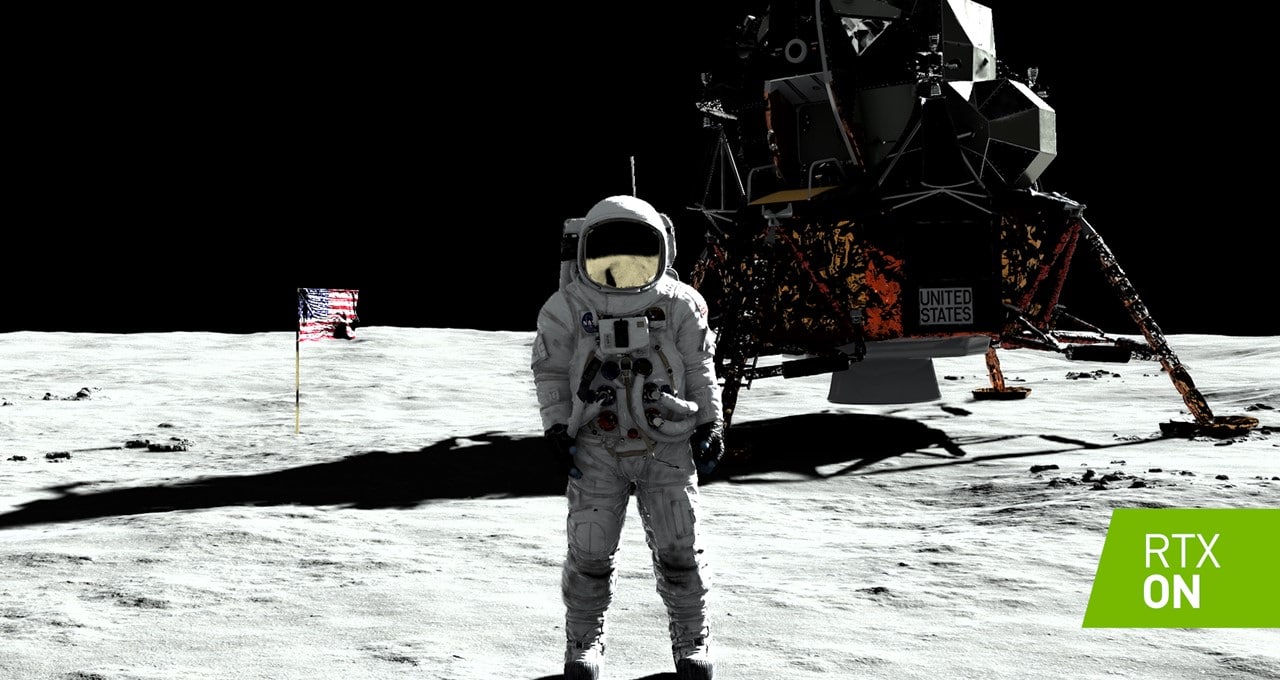With one small step, you can take a giant leap into real-time rendering at SIGGRAPH 2019 this week in Los Angeles.
To celebrate the 50th anniversary of the Apollo 11 moon landing, NVIDIA is bringing an RTX-powered interactive demo that takes attendees on a trip to the moon and back.
Visitors to the NVIDIA booth will immediately recognize a familiar, historic scene on display: a photoreal, rendered recreation of the moon landing with an astronaut standing next to the Apollo 11 lander. But, stepping closer, they’ll notice the astronaut starts to move — and it’s copying their exact movements.
A single camera is set up in the booth to capture the person’s poses and match their movements to the 3D-rendered astronaut. Using pose estimation technology designed by NVIDIA Research, the interactive demo doesn’t require any special suits, multiple cameras or a depth sensor — it just requires a willing participant and an off-the-shelf webcam.
With real-time ray tracing to render every detail, combined with Omniverse — our open collaboration platform that streamlines 2D and 3D product pipelines — we’re able to project a photoreal 3D image of attendees as if they were an astronaut exploring a real moonscape that is literally out of this world.
Moonwalk Using NVIDIA’s AI-Enhanced Technology
Previously, capturing someone’s precise movements was a difficult task due to different types of appearances, overlapping objects and complex body poses. Studios would require a large production that involves multiple cameras, full-body suits with sensors, and painstaking calibrations to accurately detect the body movements and generate 3D recreations.
Our NVIDIA Research team has developed a state-of-the-art method that reconstructs the 3D human body motion and position from a single 2D video feed. With pose estimation technology, the Tensor Cores in RTX GPUs speed up the AI inference to understand the person’s movements. That information is then translated and sent to the Omniverse renderer to match the precise movements to the 3D astronaut.
So the moment someone steps into the NVIDIA booth, they’re virtually transported into space to relive the historic moon-landing moment.
From the moon rocks strewn about to the Apollo 11 lander, the realistic details in the scene are made possible through NVIDIA RTX technology. It creates stunning levels of realism while simulating how the sun’s rays react to the moon’s surface in real time. The interplay of lights and shadows gives incredible new perspectives on the moon landing. Watch the video below to see how SIGGRAPH attendees interacted with the demo:
Learn More About NVIDIA RTX
NVIDIA RTX brings a new level of realism to computer graphics using real-time ray tracing and AI acceleration. Major studios and software application companies are choosing RTX because it provides impressive speeds for photorealistic rendering, helping designers create high-quality visuals similar to the ones built for our moon-landing demo.
Artists can also experience faster content creation workflows and GPU-powered rendering in the data center with NVIDIA RTX Server, which delivers cinematic-quality graphics enhanced by RTX ray tracing. With NVIDIA RTX Server, designers can accelerate the rendering pipeline and explore more options while creating higher quality graphics.
Take a trip to the moon powered by RTX technology in NVIDIA booths 1303 and 1313 at SIGGRAPH. See demos of the latest RTX-accelerated renderers and apps, and check out the upcoming sessions on our SIGGRAPH schedule page.
